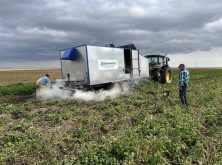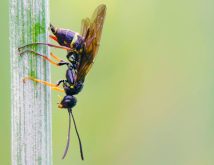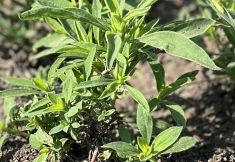Farmers who want to slow herbicide resistance need to understand weed biology, says Graham Collier.
Collier is technical services manager at Nufarm. During a plot tour at Ag-Quest west of Saskatoon, he outlined some of the factors that contribute to herbicide resistance. One factor is the average risk of the herbicide group. Weeds are more likely to develop resistant to a Group 2 than a Group 9 or 4, for example. The number of times herbicide has been applied to a field also comes into play. But not all weeds are created equal when it comes to adapting to herbicides.
Read Also

Cancer agency reclassifies another herbicide ‘probably carcinogenic’
The WHO’s cancer research agency has now put atrazine, a herbicide well known to corn growers, in the same potential-hazard category where the agency put glyphosate.
Seedbank longevity is one of the biological factors that seem counter-intuitive. The longer the seed remains viable in the soil, the less likely resistance is to spread, Collier said.
“And that’s because you’re always going to have weeds in the soil that are not resistant,” he explained. For example, if a resistant weed emerges in year 10, there will be a decade’s worth of banked seed that’s not resistant.
“And all those individuals are going to grow.”
Kochia is a weed primed to develop resistance in Western Canada. When it emerges, small hairs protect it from herbicide contact, Collier said. It produces an average of 25,000 seeds per plant.
“It’s mobile. It can spread its seed around very quickly. And it turns over its seed bank every year,” Collier said. The speed that a plant such as kochia can develop and spread herbicide resistance “is really quite stunning.”
All kochia is Group 2 resistant, said Hugh Beckie, researcher with Agriculture and Agri-Food Canada. There are also glyphosate-resistant kochia populations. Group 4 resistance has been confirmed in Saskatchewan, and is being investigated in Alberta. “And so far, unfortunately, these populations seem to be resistant to all of the Group 4s.”
Beckie and his colleagues will be surveying at least 300 sites in southern and central Alberta this fall for Group 4 and glyphosate-resistant kochia. Researchers are also investigating Group 14-resistant kochia.
“We need to really get a handle on the incidence of resistance. And then that awareness will spur action by growers,” Beckie said.
Although cleavers don’t produce as many seeds as kochia, modeling indicates cleavers are at risk to develop glyphosate resistance. And Group 2-resistant cleavers in the black soil zone “is going to become a huge issue for us moving forward — perhaps the next one,” said Collier. “And it’s going to follow a very similar pattern to what we see with kochia, as opposed to wild oats.”
Models indicate that wild oats and green foxtail are also short-listed for glyphosate resistance. Beckie is also concerned that narrow-leaved hawks beard could develop glyphosate resistance. While Beckie hopes more glyphosate-resistant weeds are a long ways into the future, farmers and industry have to be prepared for it, he said.
Collier agrees.
“The only way to stop (herbicide resistance) is to not use herbicide,” said Collier. But, he said, practices such as using multiple modes of action lower risk and push herbicide resistance down the road.
Getting samples tested
Farmers unsure whether weed problems are due to escapes or herbicide resistance can send samples to labs for screening.
Agriculture and Agri-Food Canada partners with Saskatchewan Ag’s Crop Protection Lab to test for herbicide resistance. Hugh Beckie, Ag Canada researcher, said they can test for resistance to a specific herbicide or an herbicide group.
Beckie said when the herbicide resistance testing service started in 1996, the lab received about 50 samples. The sample volume has increased, and the lab now typically receives 250 to 275 samples from across Western Canada each year. In 2013, farmers sent in a record 298 samples, Beckie said.
Once herbicide resistance is well known in an area, farmers will stop sending samples because they assume they have it. “But when it’s something new, like Group 4 kochia, that’s where we get the surge in samples,” as farmers are unsure whether it’s a resistance problem, Beckie said.
Information on Saskatchewan Agriculture’s Crop Protection Lab is available online at www.saskatchewan.ca on its Diagnose the Pest, Weed or Disease Affecting Your Crop page. Readers can also phone the lab at (306) 787-8130.
Producers and agronomists can also send samples to Ag-Quest or, for glyphosate-resistant kochia testing, the Pest Surveillance Institute Lab.
Both Ag-Quest and the Crop Protection Lab require seed samples. The Pest Surveillance Institute requires photos of the suspect patch, along with kochia plant samples. More details on sampling requirements, along with pricing, available on each lab’s website
















